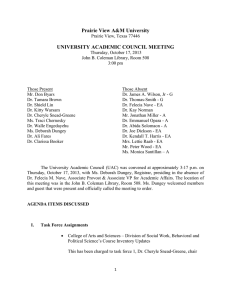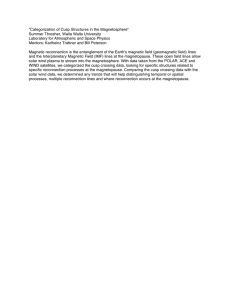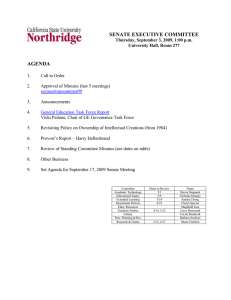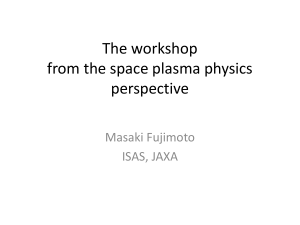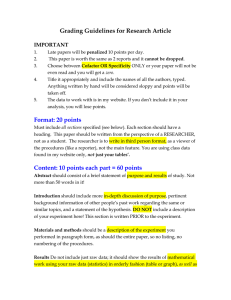Jim Dungey, The Open Magnetosphere, and Space Weather
advertisement
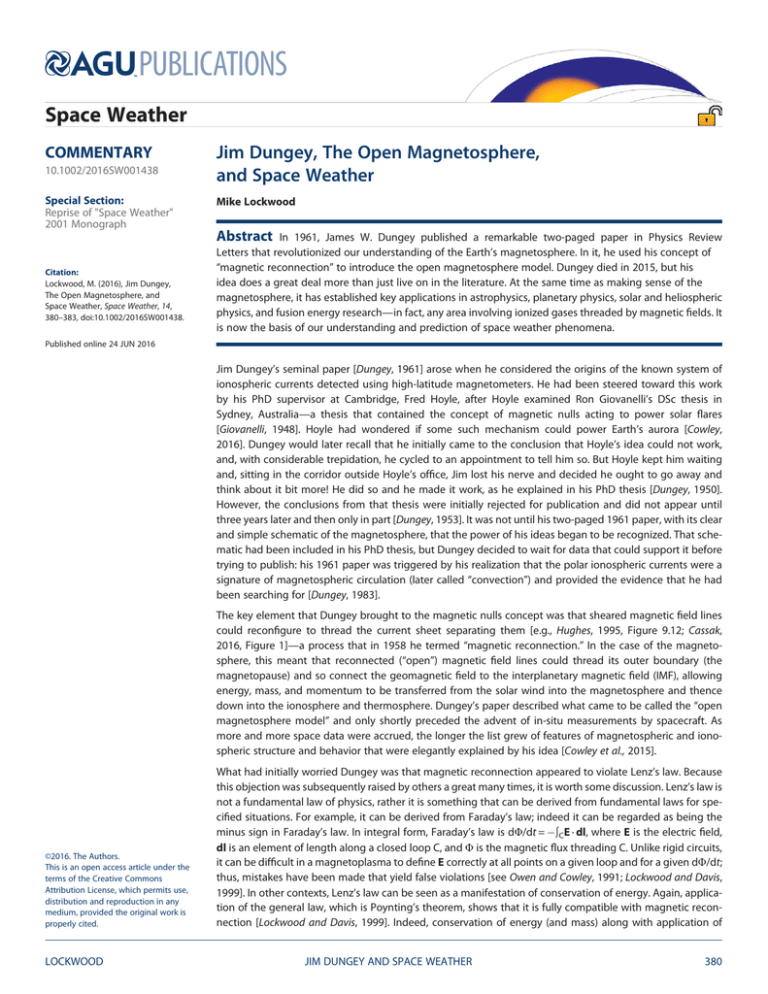
PUBLICATIONS Space Weather COMMENTARY 10.1002/2016SW001438 Special Section: Reprise of "Space Weather" 2001 Monograph Citation: Lockwood, M. (2016), Jim Dungey, The Open Magnetosphere, and Space Weather, Space Weather, 14, 380–383, doi:10.1002/2016SW001438. Jim Dungey, The Open Magnetosphere, and Space Weather Mike Lockwood Abstract In 1961, James W. Dungey published a remarkable two-paged paper in Physics Review Letters that revolutionized our understanding of the Earth’s magnetosphere. In it, he used his concept of “magnetic reconnection” to introduce the open magnetosphere model. Dungey died in 2015, but his idea does a great deal more than just live on in the literature. At the same time as making sense of the magnetosphere, it has established key applications in astrophysics, planetary physics, solar and heliospheric physics, and fusion energy research—in fact, any area involving ionized gases threaded by magnetic fields. It is now the basis of our understanding and prediction of space weather phenomena. Published online 24 JUN 2016 Jim Dungey’s seminal paper [Dungey, 1961] arose when he considered the origins of the known system of ionospheric currents detected using high-latitude magnetometers. He had been steered toward this work by his PhD supervisor at Cambridge, Fred Hoyle, after Hoyle examined Ron Giovanelli’s DSc thesis in Sydney, Australia—a thesis that contained the concept of magnetic nulls acting to power solar flares [Giovanelli, 1948]. Hoyle had wondered if some such mechanism could power Earth’s aurora [Cowley, 2016]. Dungey would later recall that he initially came to the conclusion that Hoyle’s idea could not work, and, with considerable trepidation, he cycled to an appointment to tell him so. But Hoyle kept him waiting and, sitting in the corridor outside Hoyle’s office, Jim lost his nerve and decided he ought to go away and think about it bit more! He did so and he made it work, as he explained in his PhD thesis [Dungey, 1950]. However, the conclusions from that thesis were initially rejected for publication and did not appear until three years later and then only in part [Dungey, 1953]. It was not until his two-paged 1961 paper, with its clear and simple schematic of the magnetosphere, that the power of his ideas began to be recognized. That schematic had been included in his PhD thesis, but Dungey decided to wait for data that could support it before trying to publish: his 1961 paper was triggered by his realization that the polar ionospheric currents were a signature of magnetospheric circulation (later called “convection”) and provided the evidence that he had been searching for [Dungey, 1983]. The key element that Dungey brought to the magnetic nulls concept was that sheared magnetic field lines could reconfigure to thread the current sheet separating them [e.g., Hughes, 1995, Figure 9.12; Cassak, 2016, Figure 1]—a process that in 1958 he termed “magnetic reconnection.” In the case of the magnetosphere, this meant that reconnected (“open”) magnetic field lines could thread its outer boundary (the magnetopause) and so connect the geomagnetic field to the interplanetary magnetic field (IMF), allowing energy, mass, and momentum to be transferred from the solar wind into the magnetosphere and thence down into the ionosphere and thermosphere. Dungey’s paper described what came to be called the “open magnetosphere model” and only shortly preceded the advent of in-situ measurements by spacecraft. As more and more space data were accrued, the longer the list grew of features of magnetospheric and ionospheric structure and behavior that were elegantly explained by his idea [Cowley et al., 2015]. ©2016. The Authors. This is an open access article under the terms of the Creative Commons Attribution License, which permits use, distribution and reproduction in any medium, provided the original work is properly cited. LOCKWOOD What had initially worried Dungey was that magnetic reconnection appeared to violate Lenz’s law. Because this objection was subsequently raised by others a great many times, it is worth some discussion. Lenz’s law is not a fundamental law of physics, rather it is something that can be derived from fundamental laws for specified situations. For example, it can be derived from Faraday’s law; indeed it can be regarded as being the minus sign in Faraday’s law. In integral form, Faraday’s law is dΦ/dt = ∫CE · dl, where E is the electric field, dl is an element of length along a closed loop C, and Φ is the magnetic flux threading C. Unlike rigid circuits, it can be difficult in a magnetoplasma to define E correctly at all points on a given loop and for a given dΦ/dt; thus, mistakes have been made that yield false violations [see Owen and Cowley, 1991; Lockwood and Davis, 1999]. In other contexts, Lenz’s law can be seen as a manifestation of conservation of energy. Again, application of the general law, which is Poynting’s theorem, shows that it is fully compatible with magnetic reconnection [Lockwood and Davis, 1999]. Indeed, conservation of energy (and mass) along with application of JIM DUNGEY AND SPACE WEATHER 380 Space Weather 10.1002/2016SW001438 Faraday’s law is the basis for theoretical estimation of reconnection rate. The key point is that reconnection obeys both the more general laws, and so any apparent violations of the derived law (Lenz’s) can only mean that it has been applied incorrectly. Debates of this kind meant that magnetic reconnection was not universally accepted for many years even though its predictive power had been demonstrated a great many times. This was something that Jim found somewhat baffling and bewildering [Dungey, 1994]. A search of Web of Science for the topic “magnetic reconnection” (conducted in June 2016) yielded over 23,000 journal articles, which have amassed almost a third of a million citations. These are certainly minimum estimates as many papers relying on the concept will have been missed (for example, the first listed paper is not until 1973) and papers that used alternative names such as “merging” will also not be included. A new PhD student who starts a literature survey from Dungey’s, 1961 paper may get the impression that Dungey got lucky with a two-paged paper containing some speculation and a couple of cartoons that happened to be right. This would be completely incorrect: those cartoons were the product of a decade and a half of study and thought [Dungey, 1983], some of it detailed in the book he wrote in that time [Dungey, 1958]. Of course there were also very important theoretical advances to follow, notably Harry Petschek’s addition of shocks standing in the inflow regions that explained how reconnection rates can be large enough to be significant [Petschek, 1964]. (We now know that this can be achieved by Alfvén waves and that a variety of magnetohydrodynamic structures can be present between the reconnection inflow and outflow regions). Dungey himself, being a true scientist, initially treated his own idea with all due skepticism. I was very lucky to often enjoy his company for an early evening drink (or two) in the Queen’s Arms—a small and very English public house in the mews over the road from Imperial College London. One such evening he told me he only started to be sure that reconnection was an accurate description with real predictive power (i.e., a valuable scientific theory) when spacecraft data started to show that disturbance phenomena in the magnetosphere were all enhanced when the IMF pointed southward [Fairfield and Cahill, 1966; Arnoldy, 1971]. The first key verification came from Don Fairfield who worked with Cahill’s Explorer 12 magnetometer data on the advice of Dungey, who was his PhD supervisor at Pennsylvania State University [see Dungey, 1994]. The southward IMF orientation gives large magnetic shear across the dayside magnetopause which allows reconnection there to generate open field lines rapidly. Today, this remains a key implication of Dungey’s work as it provides a means to both understand and predict space weather. Space weather phenomena are primarily driven by or modulated by Dungey’s concept of magnetic reconnection [Eastwood, 2008; Cassak, 2016]. Resulting currents in the ionospheric E layer deposit solar wind energy in the thermosphere by Joule heating, as do the associated convection plasma flows in the overlying ionospheric F layer via ion-neutral frictional heating. This heating is strongest in the auroral ovals and differences between the reconnection rates at the dayside magnetopause and in Earth’s magnetotail tail drive the substorm cycles of energy storage and deposition which launch global perturbations to thermospheric densities, winds, and temperatures [Fujiwara et al., 1996; McGranaghan et al., 2014; Emmert, 2015]. These effects influence the orbital decay of satellites and space junk [Doornbos and Klinkrad, 2006], with implications for mission planning, deorbiting of satellites, and for the detection of over-the-horizon (OTH) radar targets against the background noise of echoes from satellites and space debris. Pulses in magnetopause reconnection rate produce dense “patches” in the polar cap F region [Lockwood and Carlson, 1992] which influence satellite communications [Wang et al., 2016], GPS navigation systems [Kintner et al., 2007], and OTH radar echo location [Wheadon et al., 1994]. The energy transferred into the magnetosphere by magnetic reconnection drives geomagnetic storms, during which the most rapid variations in the geomagnetic field cause strong geomagnetically induced currents that can degrade and damage power grids [Kappenman, 2005], enhance corrosion of oil and gas pipelines [Viljanen et al., 2006], and cause errors in magnetic guidance systems, such as those needed for safe oil and gas borehole drilling [Edvardsen et al., 2013]. Magnetic reconnection also controls the near-Earth energetic particle environment within which most satellites, astronauts and aircraft operate: it is central to the occurrence of solar flares and the release of coronal mass ejections (CMEs), and the shock fronts ahead of both these phenomena accelerate bursts of solar energetic particles [Reames, 2002] that are damaging to both electronics systems and living organisms. Magnetic reconnection also determines both the emergence and loss of open solar magnetic flux [Owens and Lockwood, 2012], which modulates the galactic cosmic ray flux reaching Earth [Rouillard and Lockwood, 2004]. The reconnection-driven substorm cycles and steady LOCKWOOD JIM DUNGEY AND SPACE WEATHER 381 Space Weather 10.1002/2016SW001438 convection events inject energetic particle fluxes into the magnetospheric ring current [Reeves, 2003]. Energetic particles can cause satellite anomalies and failures [Baker, 2000] and have major implications for the design of aircraft avionics and the working radiation environment of aircraft crews [Jones et al., 2005] and astronauts [Lockwood and Hapgood, 2007]. Furthermore, application of the open magnetosphere model has allowed us to understand and reconstruct past space climate [Lockwood, 2013] and hence to start to predict its future [Barnard et al., 2011]. A new paper by Lockwood et al. [2016] studies the nature and origin of the most “geoeffective” IMF orientations that yield the largest terrestrial disturbances and the greatest space weather effects. The paper Figure 1. James W. Dungey (1923–2015) holding aloft a weather vane given demonstrates that a key factor is the to him by colleagues on his retirement in 1985. The vane is in the form of the persistence of the southward IMF, a famous schematic in his 1961 paper which introduced the concepts of factor that depends on the nature of magnetic reconnection and the open magnetosphere: a paper which is now the scientific underpinning of our understanding of how solar wind energy, the solar wind impinging upon the Earth. It is further shown that mass, and momentum enter Earth’s magnetosphere and drive space weather effects. Image credit: W.J. Hughes. the overall occurrence of strongly southward IMF in hourly averages is, somewhat surprisingly, roughly the same within CME events, around stream-stream interaction regions and during intervals of quiet solar wind. What makes CMEs a dominant driver of severe space weather is that they can provide an IMF that remains pointing strongly southward over a prolonged interval. Lockwood et al. [2016] also investigate the relative roles of the two main causes of a geoeffective IMF: geometric effects (that vary with time of day and the position of Earth in its orbit because they depend on the orientation of Earth’s magnetic axis) and an out-of-ecliptic IMF (that is either launched from the solar atmosphere or generated in interplanetary space by stream-stream interactions in the solar wind). The geometric effects cause the wellknown semiannual variation in the occurrence of space weather storms, but the study shows that this factor is increasingly less important for larger storms that are driven by strong and persistent out-of-ecliptic IMF and that show a weaker semiannual variation. None of this understanding could have been gained without Dungey’s seminal insight, which is increasingly helping us to predict space weather and understand the full extent of potential effects in “worst-case” scenarios. Acknowledgments The author’s work is supported by STFC consolidated grant ST/M000885/1. The photograph was kindly provided by Jeff Hughes of Boston University. The author also thanks two more of Dungey’s former PhD students, Stan Cowley, and David Southwood, for invaluable insights and for granting him a Visiting Lecturer position at Imperial College London that enabled him to meet and learn so much from the remarkable J. W. Dungey. LOCKWOOD Jim Dungey died on 9 May 2015 at the age of 92 [Southwood, 2015, 2016]. The attached photograph of him was taken in 1985 by his former student Jeff Hughes at Jim’s home by the Suffolk coast, as part of the celebration of his career at his retirement. He is holding aloft a weather vane that had been commissioned and presented to him by Jeff on behalf of his colleagues (Figure 1). It is in the form of the famous schematic of his open magnetosphere from which so much understanding of space weather has flowed. References Arnoldy, R. L. (1971), Signature in the interplanetary medium for substorms, J. Geophys. Res., 76(22), 5189–5201, doi:10.1029/ JA076i022p05189. Baker, D. N. (2000), The occurrence of operational anomalies in spacecraft and their relationship to space weather, IEEE Trans. Plasma Sci., 28(6), 2007–2016, doi:10.1109/27.902228. Barnard, L. A., M. Lockwood, M. A. Hapgood, M. J. Owens, C. J. Davis, and F. Steinhilber (2011), Predicting space climate change, Geophys. Res. Lett., 38, L16103, 2011, doi:10.1029/2011GL048489. JIM DUNGEY AND SPACE WEATHER 382 Space Weather 10.1002/2016SW001438 Cassak, P. A. (2016), Inside the black box: Magnetic reconnection and the magnetospheric multiscale mission, Space Weather, 14, 186–197, doi:10.1002/2015SW001313. Cowley, S. W. H. (2016), Hoyle and the magnetosphere, Astron. Geophys., 57(1), 1.12, doi:10.1093/astrogeo/atw033. Cowley, S. W. H., D. J. Southwood, and S. Mitton (Eds.) (2015), Magnetospheric Plasma Physics: The Impact of Jim Dungey’s Research, Springer, New York, doi:10.1007/978-3-319-18359-6. Doornbos, E., and H. Klinkrad (2006), Modelling of space weather effects on satellite drag, Adv. Space Res., 37(6), 1229–1239, doi:10.1016/ j.asr.2005.04.097. Dungey, J. W. (1950), Some researches in cosmic magnetism, PhD thesis, Cambridge Univ. Dungey, J. W. (1953), Conditions for the occurrence of electrical discharges in astrophysical systems, Philos. Mag., 44, 725–738, doi:10.1080/ 14786440708521050. Dungey, J. W. (1958), Cosmic Electrodynamics, Cambridge Univ. Press, Cambridge. Dungey, J. W. (1961), Interplanetary magnetic field and the auroral zones, Phys. Rev. Lett., 6, 47–48, doi:10.1103/physrevlett.6.47. Dungey, J. W. (1983) ISI citation classic: Interplanetary magnetic-field and the auroral- zones, Curr. Contents/Phys Chem. Earth, 49, 20, http:// garfield.library.upenn.edu/classics1983/A1983RQ98100001.pdf. Dungey, J. W. (1994), Memories, maxims, and motives, J. Geophys. Res., 99(A10), 19,189–19,197, doi:10.1029/94JA00105. Eastwood, J. P. (2008), The science of space weather, Phil. Trans. Roy. Soc. A, 366(1884), 4489–4500, doi:10.1098/rsta.2008.0161. Edvardsen, I., T. L. Hansen, M. Gjertsen, and H. Wilson (2013), Improving the accuracy of directional wellbore surveying in the Norwegian Sea, Soc. Petrol. Eng. Drill. Complet., 28(2), 158–167, doi:10.2118/159679-PA. Emmert, J. T. (2015), Thermospheric mass density: A review, Adv. Space Res., 56(5), 773–824, doi:10.1016/j.asr.2015.05.038. Fairfield, D. H., and L. J. Cahill Jr. (1966), Transition region magnetic field and polar magnetic disturbances, J. Geophys. Res., 71(1), 155–169, doi:10.1029/jz071i001p00155. Fujiwara, H., S. Maeda, H. Fukunishi, T. J. Fuller-Rowell, and D. S. Evans (1996), Global variations of thermospheric winds and temperatures caused by substorm energy injection, J. Geophys. Res., 101(A1), 225–239, doi:10.1029/95JA01157. Giovanelli, R. G. (1948) Studies of the physics of the Sun’s atmosphere, D.Sc. thesis, Univ. of Sydney. Hughes, W. J. (1995), The magnetopause, magnetotail and magnetic reconnection, in Introduction to Space Physics, edited by M. G. Kivelson and C. T. Russell, Cambridge Univ. Press, Cambridge. Jones, J. B. L., R. D. Bentley, R. Hunter, R. H. A. Iles, G. C. Taylor, and D. J. Thomas (2005), Space weather and commercial airlines, Adv. Space Res., 36, 2258–2267, doi:10.1016/j.asr.2004.04.017. Kappenman, J. G. (2005), An overview of the impulsive geomagnetic field disturbances and power grid impacts associated with the violent Sun–Earth connection events of 29–31 October 2003 and a comparative evaluation with other contemporary storms, Space Weather, 3, S08C01, doi:10.1029/2004SW000128. Kintner, P. M., B. M. Ledvina, and E. R. de Paula (2007), GPS and ionospheric scintillations, Space Weather, 5, S09003, doi:10.1029/ 2006SW000260. Lockwood, M. (2013) Reconstruction and prediction of variations in the open solar magnetic flux and interplanetary conditions, Living Rev. Sol. Phys., 10, 4, doi:10.12942/lrsp-2013-4. Lockwood, M., and H. C. Carlson Jr. (1992), Production of polar cap electron density patches by transient magnetopause reconnection, Geophys. Res. Lett., 19, 1731–1734, doi:10.1029/92GL01993. Lockwood, M., and C. J. Davis (1999), The correct application of Poynting’s theorem to the time-dependent magnetosphere: Reply to Heikkila, Ann. Geophys., 17, 178–181, doi:10.1007/s00585-999-0178-2. Lockwood, M., and M. A. Hapgood (2007), The rough guide to the Moon and Mars, Astron. Geophys., 48, 11–17, doi:10.1111/ j.1468-4004.2007.48611.x. Lockwood, M., M. J. Owens, L. A. Barnard, S. Bentley, C. J. Scott, and C. E. Watt (2016), On the origins and timescales of geoeffective IMF, Space Weather, 14, doi:10.1002/2016SW001375. McGranaghan, R., D. J. Knipp, R. L. McPherron, and L. A. Hunt (2014), Impact of equinoctial high-speed stream structures on thermospheric responses, Space Weather, 12, 277–297, doi:10.1002/2014SW001045. Owen, C. J., and S. W. H. Cowley (1991), Heikkila’s mechanism for impulsive plasma transport through the magnetopause: A re-examination, J. Geophys. Res., 96, 5565–5574, doi:10.1029/90JA02695. Owens, M. J., and M. Lockwood (2012), Cyclic loss of open solar flux since 1868: The link to heliospheric current sheet tilt and implications for the Maunder Minimum, J. Geophys. Res., 117, A04102, doi:10.1029/2011JA017193. Petschek, H. E. (1964), Magnetic field annihilation, The Physics of Solar Flares, edited by W. N. Hess. Proc. AAS-NASA Symposium, 28–30 October, 1963, NASA/GSFC, pp. 425–439. [Available at http://articles.adsabs.harvard.edu/full/1964NASSP..50..425P.] Reames, D. V. (2002), Magnetic topology of impulsive and gradual solar energetic particle events, Astrophys. J., 571, L63–L66, doi:10.1086/ 341149. Reeves, G. D., et al. (2003), IMAGE, POLAR, and Geosynchronous Observations of Substorm and Ring Current Ion Injection, in Disturbances in Geospace: The Storm-Substorm Relationship, edited by A. S. Sharma, Y. Kamide, and G. S. Lakhina, AGU, Washington, D. C., doi:10.1029/ 142GM09. Rouillard, A. P. and M. Lockwood (2004) Oscillations in the open solar magnetic flux with period 1.68 years: imprint on galactic cosmic rays and implications for heliospheric shielding, Ann. Geophys., 46(22), 4381–4395, doi:10.5194/angeo-22-4381-2004. Southwood, D. (2015), James Wynne Dungey 1923–2015, Astron. Geophys., 56, 8, doi:10.1093/astrogeo/atv162. Southwood, D. (2016), James Wynne Dungey (1923–2015), Eos Trans. AGU, 97, doi:10.1029/2016EO044731. Viljanen, A., A. Pulkkinen, R. Pirjola, K. Pajunpää, P. Posio, and A. Koistinen (2006), Recordings of geomagnetically induced currents and a nowcasting service of the Finnish natural gas pipeline system, Space Weather, 4, S10004, doi:10.1029/2006SW000234. Wang, Y., Q.-H. Zhang, P. T. Jayachandran, M. Lockwood, S.-R. Zhang, J. Moen, Z.-Y. Xing, Y.-Z. Ma, and M. Lester (2016), A comparison between large-scale irregularities and scintillations in the polar ionosphere, Geophys. Res. Lett., 43, doi:10.1002/2016GL069230. Wheadon, N. S., J. C. Whitehouse, J. D. Milsom, and R. N. Herring (1994), Ionospheric modelling and target coordinate registration for HF sky-wave radars, Proc. 6th Int. Conf. on HF Radio Systems and Techniques, 4–7 July 1994, pp. 258–266, doi:10.1049/cp:19940504. Mike Lockwood, FRS is a professor of Space Plasma Physics at the University of Reading, UK. Email: m.lockwood@reading.ac.uk. LOCKWOOD JIM DUNGEY AND SPACE WEATHER 383
